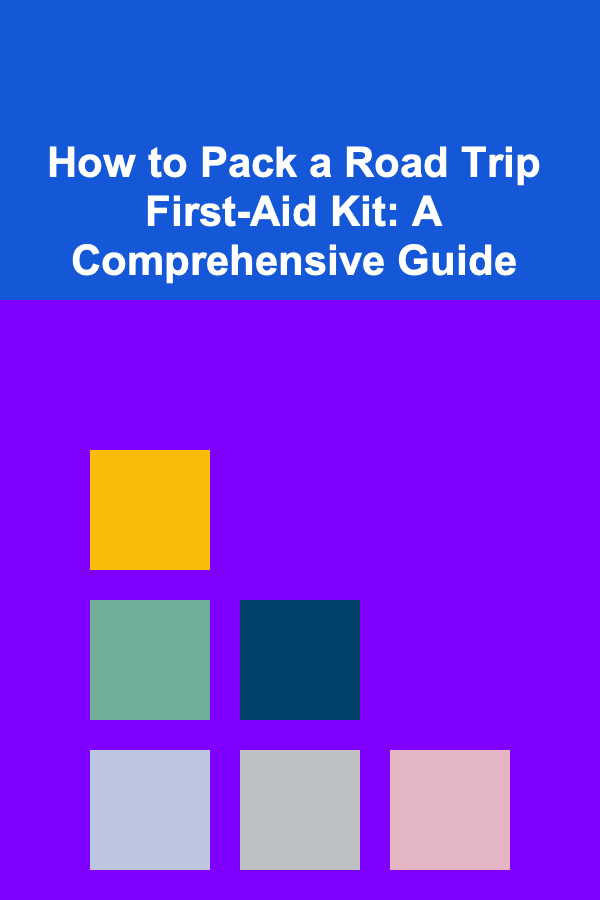
How to Pack a Road Trip First-Aid Kit: A Comprehensive Guide
ebook include PDF & Audio bundle (Micro Guide)
$12.99$5.99
Limited Time Offer! Order within the next:

Embarking on a road trip is one of the best ways to explore new places, experience different cultures, and make lasting memories. However, while these adventures can be exciting, they also come with their share of risks. Whether you're tackling a mountain pass, hiking to a remote waterfall, or cruising along the coastline, accidents can happen, and being prepared is key to staying safe.
One essential aspect of road trip preparation is packing a well-stocked first-aid kit. A first-aid kit ensures that you have the necessary supplies to treat minor injuries and address health issues on the go. In this comprehensive guide, we'll take you through how to pack the perfect first-aid kit for your road trip, detailing the items to include, tips for using them, and some general road safety advice.
Understanding the Basics of a Road Trip First-Aid Kit
A well-packed first-aid kit doesn't have to be cumbersome or take up a lot of space. The goal is to ensure that you can handle a variety of potential medical situations, ranging from small cuts and burns to more serious conditions like allergic reactions or dehydration. Packing thoughtfully is the key to an effective first-aid kit.
Why You Need a First-Aid Kit
Accidents on road trips are often unpredictable, and even minor injuries or health problems can become major issues if not handled properly. Having the right supplies on hand can help prevent a small cut from getting infected, alleviate the pain from a burn, or provide temporary relief until professional medical help is available. A first-aid kit ensures that you're not left scrambling for solutions when emergencies arise.
Basic Components Every Road Trip First-Aid Kit Should Have
When packing your first-aid kit for a road trip, it's important to cover the essentials. The following items are universally recommended for all road trip first-aid kits:
A. Adhesive Bandages (Band-Aids)
These are crucial for covering small cuts, blisters, or abrasions. Pack a variety of sizes, as different wounds may require different bandage sizes.
B. Antiseptic Wipes and Ointment
Antiseptic wipes help clean wounds and prevent infection. An antiseptic ointment, such as Neosporin, can also help prevent infections in cuts and scrapes.
C. Gauze Pads and Medical Tape
For larger cuts or wounds, gauze pads can help absorb blood and keep the area clean. Medical tape will help secure the gauze in place.
D. Sterile Cotton Balls and Swabs
These are useful for cleaning wounds or applying ointments. They are especially helpful when you need to be precise about where the medication is applied.
E. Burn Cream or Gel
If you're planning on cooking, grilling, or even spending time in the sun, a burn cream or gel will provide relief and help prevent infections.
F. Pain Relievers
A mix of over-the-counter pain relievers such as ibuprofen, aspirin, or acetaminophen is essential. These can be used for headaches, body aches, or even more serious pain from injuries.
G. Allergy Medications (Antihistamines)
If you or your travel companions have allergies, it's vital to carry antihistamines like Benadryl. This can help treat allergic reactions to insect stings, plants, or food.
H. Tweezers
A good pair of tweezers is essential for removing splinters, ticks, or debris from wounds. They can also help with other small tasks like pulling out a thorn or tick from the skin.
I. Scissors
Small, sharp scissors will come in handy for cutting bandages, medical tape, or even trimming clothing in an emergency situation.
J. Thermometer
A thermometer allows you to check for fever, which can indicate illness or infection. It's particularly useful if someone starts feeling unwell during the trip.
Medications and Other Essentials
In addition to the basics listed above, there are several other medications and supplies that can be particularly useful on a road trip, depending on the environment and activities you plan to engage in.
A. Motion Sickness Pills
If you or someone in your group is prone to motion sickness, it's crucial to bring motion sickness pills like Dramamine. These will help reduce nausea and discomfort during long drives or bumpy roads.
B. Anti-diarrheal Medication
For road trips, especially in areas with unfamiliar food or water, carrying anti-diarrheal medications like Imodium can save you from discomfort in case of stomach issues.
C. Insect Repellent
Road trips to national parks, hiking trails, or rural areas often expose you to insects such as mosquitoes, ticks, or ants. A high-quality insect repellent will prevent insect bites, which can be particularly dangerous if you're allergic to them or are in areas with a risk of Lyme disease.
D. Hydrocortisone Cream
For relieving skin rashes or irritations caused by plants, bug bites, or allergies, hydrocortisone cream can be extremely effective in reducing swelling and itchiness.
E. Cold Pack or Ice Packs
For treating sprains, strains, or any injury requiring cold compression, having a cold pack or instant ice pack in your first-aid kit is essential. This can help reduce swelling and pain.
F. Snake Bite Kit
If your road trip takes you through snake-prone areas, consider carrying a snake bite kit. These kits typically include suction devices to remove venom and instructions for proper first-aid measures.
G. Moleskin for Blisters
If you're doing a lot of walking or hiking, moleskin is a lifesaver for preventing or treating blisters. Simply apply it to the affected area, and it will protect your skin from further irritation.
Special Considerations for Road Trips
In addition to the standard first-aid items, there are a few special considerations depending on the type of road trip you're taking, the climate, and your personal health needs.
A. Climate and Terrain Considerations
For trips that will take you through extreme climates or varied terrain, your first-aid kit should reflect those conditions:
- Cold Weather: If you're going to be in cold climates, be sure to pack items like lip balm, sunscreen (yes, you can get sunburned even in cold weather), and hand warmers. Frostbite and hypothermia are real threats in freezing environments, so pack extra layers and blankets.
- Hot Weather: In hot, sunny environments, sunscreen is an absolute must. You should also consider electrolyte tablets or sports drinks to stay hydrated and avoid heat-related illnesses like heat stroke or dehydration.
- Rural or Remote Areas: If you're traveling through remote areas, particularly in the wilderness, it's advisable to bring along extra emergency items such as a whistle, flashlight, multitool, and emergency blanket.
B. Personal Medical Needs
If you or a member of your party has any chronic conditions, be sure to bring any necessary medications such as insulin for diabetics, inhalers for asthma sufferers, or an EpiPen for those with severe allergies. Always have extra supplies to last longer than the duration of the trip in case of delays or emergencies.
Organizing and Storing Your First-Aid Kit
How you organize and store your first-aid kit is just as important as what you put inside it. The last thing you want is to be fumbling through your bag or car to find an essential item when you're in a stressful situation.
A. Use a Compact and Durable Bag
Choose a bag that is compact enough to fit in your car, but large enough to hold all your essential items. It should be made of durable material and be easy to open. Ideally, it should have multiple compartments to separate different types of items.
B. Make It Accessible
Keep your first-aid kit in a place that is easily accessible in your vehicle. The glove compartment or the center console are great options, but make sure it's within easy reach if you need it in an emergency.
C. Label Everything
To avoid confusion in an emergency, label the compartments of your first-aid kit. This will help you quickly locate specific items when time is of the essence.
Additional Emergency Items to Consider
Aside from the basic first-aid supplies, there are a few extra items you might want to consider for a truly comprehensive road-trip first-aid kit:
- Emergency Blanket: A lightweight, space-saving way to keep warm in case of a breakdown in cold weather.
- Multitool: Useful for opening bottles, cutting bandages, or dealing with other unexpected situations.
- Flashlight and Extra Batteries: Essential for nighttime emergencies, breakdowns, or if you need to assess an injury after dark.
Final Thoughts on Road Trip First-Aid Kits
Packing a first-aid kit for your road trip may not be the most exciting part of your planning, but it's one of the most important. Having a well-stocked kit allows you to respond to injuries or illnesses quickly and effectively, ensuring your road trip remains a safe and enjoyable experience. Whether you're traveling alone or with friends, being prepared for medical emergencies will provide peace of mind and make your journey more enjoyable.
Remember, a first-aid kit is just one part of being prepared for a road trip. Always inform someone of your travel plans, stay updated on the weather, and follow all road safety guidelines. The combination of preparation, safety, and awareness will help ensure that your trip is one filled with fun, not unforeseen emergencies.
Happy travels!
Reading More From Our Other Websites
- [Organization Tip 101] How to Create a Digital Reference Library
- [Home Maintenance 101] How to Use Your Appliance Warranty Effectively
- [Home Budget Decorating 101] How to Upcycle Old Furniture into Unique Statement Pieces
- [Home Soundproofing 101] How to Use Insulation for Effective Home Soundproofing
- [Biking 101] How to Choose the Best Cross Country Bike for Your Trail Adventures
- [Organization Tip 101] How to Organize Your Child's Artwork and School Projects
- [Toy Making Tip 101] Crafting Custom Action Figures with Polymer Clay
- [Personal Care Tips 101] How to Choose Personal Care Products That Are Cruelty-Free and Environmentally Friendly
- [Organization Tip 101] How to Use Spreadsheets for Personal and Professional Organization
- [Organization Tip 101] How to Tackle Bedroom Clutter in 10 Minutes a Day

How to Budget for a Large Family on a Single Income
Read MoreHow to Create a System for Tracking Home Maintenance
Read More
How to Plan a Minimalist Home Budget That Focuses on Essentials
Read More
How to Save Space in a Studio Apartment with Zoning Techniques
Read More
How to Stage a Bedroom to Look Bigger and More Relaxing
Read More
How to Use Options Trading to Boost Your Investment Strategy
Read MoreOther Products

How to Budget for a Large Family on a Single Income
Read MoreHow to Create a System for Tracking Home Maintenance
Read More
How to Plan a Minimalist Home Budget That Focuses on Essentials
Read More
How to Save Space in a Studio Apartment with Zoning Techniques
Read More
How to Stage a Bedroom to Look Bigger and More Relaxing
Read More